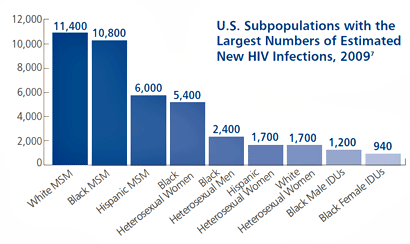Populations at Greatest Risk
While all Americans are affected by the HIV epidemic, some populations bear an especially heavy burden and account for the largest numbers of HIV infections. Success in HIV prevention can only be achieved by addressing these disparities and working to achieve health equity. Hard-hit populations include:
- Gay and bisexual men of all races and ethnicities remain the group most severely and disproportionately affected by the epidemic. Men who have sex with men (MSM*) represent approximately 2 percent of the U.S. population, but accounted for 61 percent** of all new HIV infections in 2009.7,12 By race, age and risk group, young, black gay and bisexual men (ages 13-29) are the only population in the United States in which new HIV infections increased between 2006 and 2009.7
- African Americans are by far the most affected racial/ethnic population in the United States. African Americans represent 14 percent of the U.S. population, but accounted for 44 percent of new HIV infections in 2009. The HIV infection rate among African Americans was almost eight times as high as that of whites in 2009, and among African American women it was 15 times higher than among white women.7
- Latinos are also disproportionately affected by HIV, representing approximately 16 percent of the total U.S. population, but accounting for 20 percent of all new HIV infections. In 2009, the HIV infection rate among Latinos was three times as high as that of whites.7
*The term men who have sex with men is used in CDC surveillance systems because it indicates the behaviors that transmit HIV infection, rather than how individuals self-identify in terms of their sexuality.
**This figure does not include MSM who are also injection drug users. MSM-IDUs accounted for 3 percent of new HIV infections in 2009. - Injection drug users (IDUs) represented 9 percent of new HIV infections in 2009. African Americans accounted for 48 percent of new infections among IDUs, and Latinos accounted for 21 percent.7
- Transgender individuals are heavily affected by HIV. A 2008 review of studies of HIV among male-to-female women found that, on average, 28 percent tested positive for HIV.13
- Page last reviewed: November 16, 2015
- Page last updated: November 16, 2015
- Content source: Division of HIV/AIDS Prevention, National Center for HIV/AIDS, Viral Hepatitis, STD, and TB Prevention, Centers for Disease Control and Prevention


 ShareCompartir
ShareCompartir